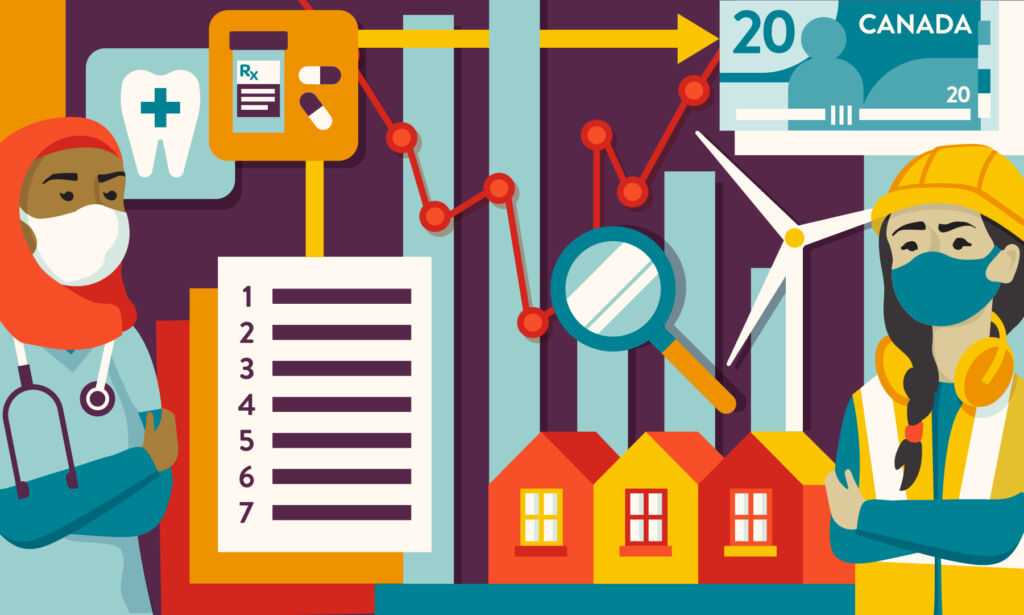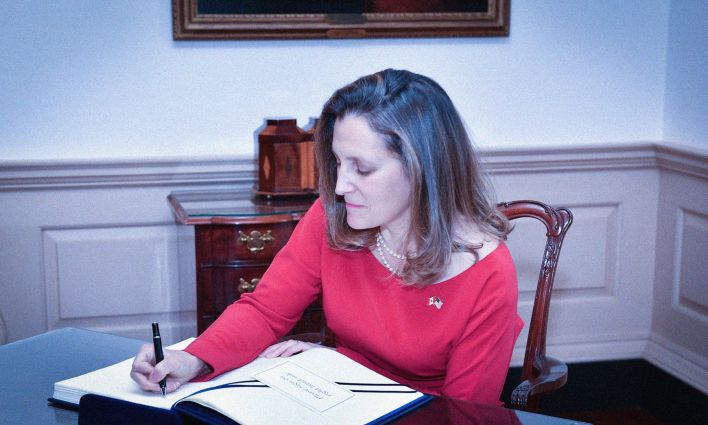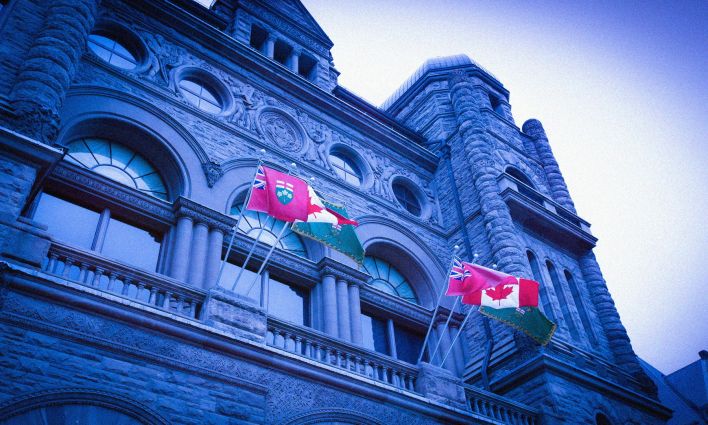In a surprise move, the federal Liberal minority government has struck a deal with the NDP that will ostensibly secure a stable minority government until 2025.
Canada doesn’t have many recent examples of minority governments that work closely with another party to secure stability, but one federal example springs to mind: in the 1960s Lester Pearson’s Liberals struggled to win a majority government. Pearson worked with the newly formed NDP, then led by Tommy Douglas, to forge a progressive pact.
That pact included a deal to take Douglas’ universal public health care program in Saskatchewan and make it national. It promised the creation of a public pension system. And it introduced affordable university tuition, opening the door to higher education for Canada’s middle class. This era also saw the overhaul of the employment insurance (EI) system toward a universal, social policy approach, and the creation of a serious social housing program.
Could the new Liberal-NDP pact herald in a new progressive era and tackle the glaring disparities revealed by the pandemic while positioning Canada for a more inclusive, safer, just future?
With hardening right-wing views on the Prairies and a federal Conservative Party that seems unbending, the Liberal-NDP alignment might stoke already smoldering western alienation feelings; conversely, it may assuage some of those feelings if the federal government is seen to be delivering real change that visibly helps people. But one thing is clear: Federally speaking, at least, Canada won’t be swerving to a hard-right government in the immediate future. It will be interesting to see how this agreement influences Conservative decisions about which leader can take them to a win in 2025.
The Liberal-NDP agreement presents a seven-point plan: (1) a better health care system (2) making life more affordable for people (3) tackling the climate crisis and creating good-paying jobs (4) a better deal for workers (5) reconciliation (6) a fairer tax system (7) and making democracy work for people.
Much of this was in the Liberal platform in last year’s election. But under the health care system plan, dental care and pharmacare have finally secured their moment in the sun—a win for the NDP.
As a package, it’s a progressive agenda that sidelines the fiscal austerity hawks for now, but it is hardly bold. Given the global uncertainties on a growing number of fronts, there is room for bolder progressive government. Some of those priorities, detailed in the CCPA’s annual Alternative Federal Budget (AFB), include: reforming Canada’s income security system; implementing a wealth tax; investing boldly in sustainable, livable cities; and placing a moratorium on new fossil fuel extraction, among other proposals.
What’s on the table, and what’s missing?
Housing: The new agreement adds nothing fundamentally new, only more of the half-measures and vague promises found in both the Liberal and NDP platforms.
The Rapid Housing Initiative (RHI)—which funds the acquisition and construction of social and supportive housing—is being extended for one year. The RHI was a late addition to the National Housing Strategy (NHS), but it has delivered more and faster housing than other NHS initiatives. The two parties should have made it a permanent funding stream.
The Rental Construction Financing Initiative (RCFI) is being refocused on affordable units—as opposed to the general increase of supply of rental housing—which would be a good thing, if the affordable housing units it funds were actually affordable. The RCFI used to use 30% of median income as the affordability criteria, and it will now use 80% of average market rents. We explained last year why this is the wrong approach.
The Liberal-NDP agreement also promises a Homebuyer’s Bill of Rights and measures to tackle the financialization of the housing market by the end of 2023. Both items were in the Liberal platform, only the deadline is new.
The agreement also includes a $500 one-time top-up of the Canada Housing Benefit, to be “renewed in coming years if cost of living challenges remain.” This top-up translates to $42 a month, not much for eligible low-income households who have likely seen rents increase over the pandemic.
This half-measure approach is unjustifiable in light of skyrocketing shelter costs, the impact of inflation on low-income households, and the inadequacy of income supports. A progressive coalition would go much further.
Education: The process of rolling out early childhood learning and child care program is well underway and it's good to see agreement on creating a non-profit, fair and accessible system.
But adequate support for post-secondary students must also be part of the larger discussion about affordability, and unfortunately it’s absent from this plan.
The working agreement presented the perfect moment to speak to the issue of student debt accumulation and its long-lasting effects; to ensure adequate public funding for post-secondary institutions and stem the creep of privatization and the rise of multi-tier provincial tuition fee schemes; to address the volatile job market for this generation and the prevalence of precarious employment (including for precariously employed workers in the university and college sector) in which so many young people find themselves trapped. Unfortunately, these issues didn’t make the cut.
Caring economy: The agreement locks in key caring economy pieces but there’s meat to put on these bones. What will the promised Safe Long-Term Care act do? How will the government ensure that seniors receive “the care they deserve” and that care workers are paid deserving wages? How will it ensure that public funds are directed to public and non-profit providers, and not to for-profit companies that earned sizable profits as vulnerable seniors died in their care?
The new dental program for low-income Canadians is an important step forward, filling a critical gap in our universal health care system. It’s means tested, and while a universal approach is best, it is movement forward on an important part of health care. However, there will be difficult negotiations ahead with the provinces and territories and private insurance interests intent on preserving their profitable slice of dental services.
On health care more broadly, how will the government (working with the provinces and territories) “deliver better health outcomes for Canadians”? The unprecedented, but temporary, federal transfers to the provinces for COVID-19 expenses likely pushed federal spending to 35% of all health care spending, which the provinces have been looking for. If the health care portion of this agreement makes that 35% target an official part of federal policy, that would be a huge win, assuming it comes with guarantees related to public administration of health care and the other principles enshrined in the Canada Health Act.
Will the new Canada Pharmacare Act lay the foundation for a truly universal and appropriately resourced program to ensure all Canadians have access to essential medications? We’ll have to wait for Budget 2022 to see if the fine print matches progressive expectations.
Income security: At the press conference announcing the agreement, NDP Leader Jagmeet Singh stated the pact is “the start of an important journey to get help to people.” We can hope the two parties turn their immediate attention to income security reform.
The rising cost of living bites hard for those who are just scraping by, especially when it comes to food, housing and medication.
One of the big pushes this year will be EI reforms to cover self-employed workers as well as keeping entrance requirements low. The Liberal platform committed to completing this by the end of 2022. With that commitment in place the NDP perhaps wasn’t interested in having it be part of their official agreement. A quick win on this file would be addressing the misclassification problem, where gig-economy employers pretend their employees aren’t employees in order to skip their EI premium. Legislative amendments already exist on this front and could easily be put in place.
The proposed Canada Disability Benefit must also be on the action list. Such a benefit has the potential of lifting working-aged people with disabilities out of poverty, while redirecting critical funding to provide much-needed community support services. The CCPA has provided one example of how such a benefit could work in the AFB. What’s essential is that people with disabilities lead the reform efforts.
Reconciliation: The NDP-Liberal agreement focuses on three areas related to reconciliation: making a “significant additional investment” in Indigenous-led housing in 2022; accelerating implementation of the Federal Pathway to Address Missing and Murdered Indigenous Women, Girls and 2SLGBTQQIA+ People with Indigenous partners, as well as promising to create a standing Federal-Provincial-Territorial table to coordinate this work; and, in line with the Liberal platform, providing necessary supports for First Nations, Inuit and Métis communities who wish to undertake burial searches at former residential schools.
However, much more substantial action is left to be done. A recent report from the Yellowhead Institute notes that “with each passing year, Canada opts to perform reconciliation in an effort to shape a benevolent reputation rather than enact the substantial and structural changes that would rectify ongoing harms and change the course of our collective relationship.”
Last year, there was more movement on the Truth and Reconciliation Commission’s Calls to Action in the three weeks following the first revelations of children’s graves outside residential schools, than in the previous three years combined. Any positive movement on Calls to Action is good news, but it should not take profoundly disturbing revelations to move reconciliation ahead. “Real and meaningful transformative change to underlying systems of oppression—not just individual tinkering around the edges of a broken colonial machine—is, therefore, required,” Yellowhead notes.
Defence spending: The agreement makes no mention of defence, but Canada is under pressure from NATO countries and hawkish elements domestically to increase military spending in response to Russia’s invasion of Ukraine. Canada should be helping Ukraine end the war as soon as possible and defend itself against Putin’s aggression, while offering as much humanitarian assistance as possible. But ultimately, it is critically important that we are doing whatever we can to de-escalate. The crisis drives home the unchecked existential threat of nuclear weapons and their proliferation. Peace and disarmament, not rearmament, must be the priority. It is also important that much-needed international assistance to Ukraine not be provided at the expense of efforts to address the harms caused by ongoing humanitarian crises in Afghanistan, Yemen, Sudan, Myanmar and elsewhere.
Climate change: The Liberal-NDP agreement includes a noteworthy new commitment to support energy efficiency improvements in low-income and multi-unit residential apartments. Historically, energy efficiency programs have disproportionately benefited high-income homeowners who could afford the upfront cost of retrofits, so this new commitment could herald a more equitable and effective energy efficiency program. Otherwise, the agreement mainly reiterates the Liberal climate platform, which is good but not great. The severity of the climate emergency means we can’t afford to wait or rely on half measures, so hopefully further Liberal-NDP collaboration leads to a ramping up of ambitions at a time when many provinces are reluctant to take action.
Taxing the rich: To fund a progressive agenda, the federal government must look to new revenue measures—such as a progressive wealth tax, a corporate super-profits tax, and a minimum tax on multinationals—to facilitate needed financial stability and a much greater measure of equity in the tax system. The agreement’s pledge to tax windfall profits generated by financial institutions over the last two years is a great start, but there is considerable scope for more action. CCPA-BC Senior Economist Marc Lee makes the case for a windfall tax on oil and gas profits—funds that could not only be redistributed to low-income households, but help us with the critical work of transitioning from fossil fuels.
Investing in our democracy: Coming a month after the occupation of downtown Ottawa, new ideas to strengthen our democratic institutions are welcome. The focus of the Liberal-NDP agreement on removing barriers to voting is crucial to ensuring the active participation of marginalized communities in the electoral process, the diversity of those chosen to govern, and the legitimacy of the system itself.
There is an opportunity to change how politics is practiced and to raise the bar on transparency and accountability. This includes investing in a vibrant civil society and nonprofit organizations that engage, connect and serve communities. At present, the nonprofit sector is struggling in the aftermath of a difficult two years of heightened demand and much reduced capacity. Now is the time to reset the vital relationship between the federal government and nonprofit sector through long-term funding reform and sustained, meaningful engagement.



















